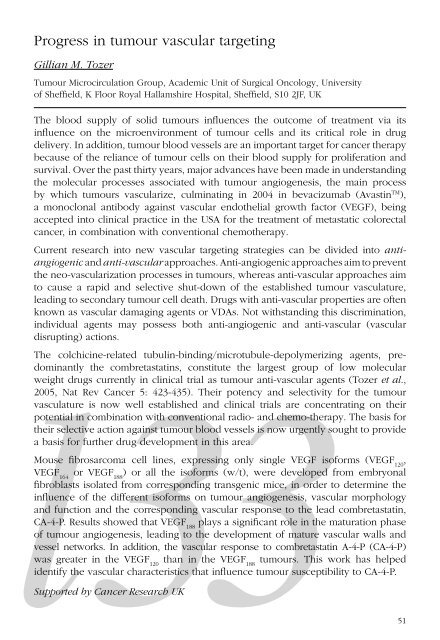Create successful ePaper yourself
Turn your PDF publications into a flip-book with our unique Google optimized e-Paper software.
Progress in tumour vascular targeting<br />
Gillian M. Tozer<br />
Tumour Microcirculation Group, Academic Unit of Surgical Oncology, University<br />
of Sheffield, K Floor Royal Hallamshire Hospital, Sheffield, S10 2JF, UK<br />
The blood supply of solid tumours influences the outcome of treatment via its<br />
influence on the microenvironment of tumour cells and its critical role in drug<br />
delivery. In addition, tumour blood vessels are an important target for cancer therapy<br />
because of the reliance of tumour cells on their blood supply for proliferation and<br />
survival. Over the past thirty years, major advances have been made in understanding<br />
the molecular processes associated with tumour angiogenesis, the main process<br />
by which tumours vascularize, culminating in 2004 in bevacizumab (Avastin TM ),<br />
a monoclonal antibody against vascular endothelial growth factor (VEGF), being<br />
accepted into clinical practice in the USA for the treatment of metastatic colorectal<br />
cancer, in combination with conventional chemotherapy.<br />
Current research into new vascular targeting strategies can be divided into antiangiogenic<br />
and anti-vascular approaches. Anti-angiogenic approaches aim to prevent<br />
the neo-vascularization processes in tumours, whereas anti-vascular approaches aim<br />
to cause a rapid and selective shut-down of the established tumour vasculature,<br />
leading to secondary tumour cell death. Drugs with anti-vascular properties are often<br />
known as vascular damaging agents or VDAs. Not withstanding this discrimination,<br />
individual agents may possess both anti-angiogenic and anti-vascular (vascular<br />
disrupting) actions.<br />
l33<br />
51<br />
The colchicine-related tubulin-binding/microtubule-depolymerizing agents, predominantly<br />
the combretastatins, constitute the largest group of low molecular<br />
weight drugs currently in clinical trial as tumour anti-vascular agents (Tozer et al.,<br />
2005, Nat Rev Cancer 5: 423-435). Their potency and selectivity for the tumour<br />
vasculature is now well established and clinical trials are concentrating on their<br />
potential in combination with conventional radio- and chemo-therapy. The basis for<br />
their selective action against tumour blood vessels is now urgently sought to provide<br />
a basis for further drug development in this area.<br />
Mouse fibrosarcoma cell lines, expressing only single VEGF isoforms (VEGF 120<br />
,<br />
VEGF 164<br />
or VEGF 188<br />
) or all the isoforms (w/t), were developed from embryonal<br />
fibroblasts isolated from corresponding transgenic mice, in order to determine the<br />
influence of the different isoforms on tumour angiogenesis, vascular morphology<br />
and function and the corresponding vascular response to the lead combretastatin,<br />
CA-4-P. Results showed that VEGF 188<br />
plays a significant role in the maturation phase<br />
of tumour angiogenesis, leading to the development of mature vascular walls and<br />
vessel networks. In addition, the vascular response to combretastatin A-4-P (CA-4-P)<br />
was greater in the VEGF 120<br />
than in the VEGF 188<br />
tumours. This work has helped<br />
identify the vascular characteristics that influence tumour susceptibility to CA-4-P.<br />
Supported by Cancer Research UK
















